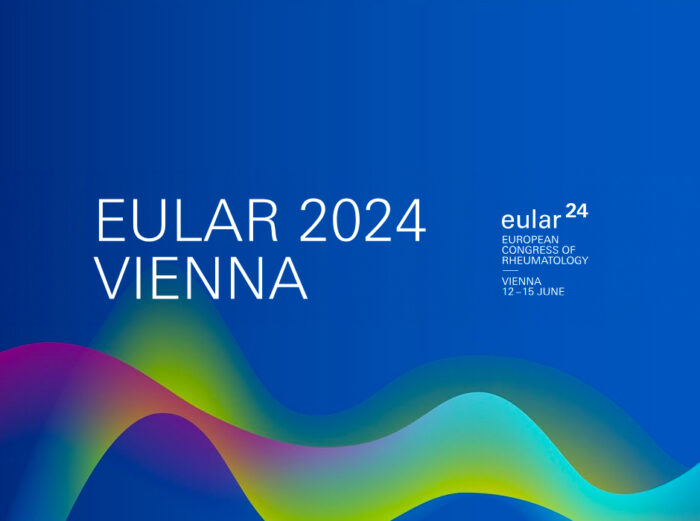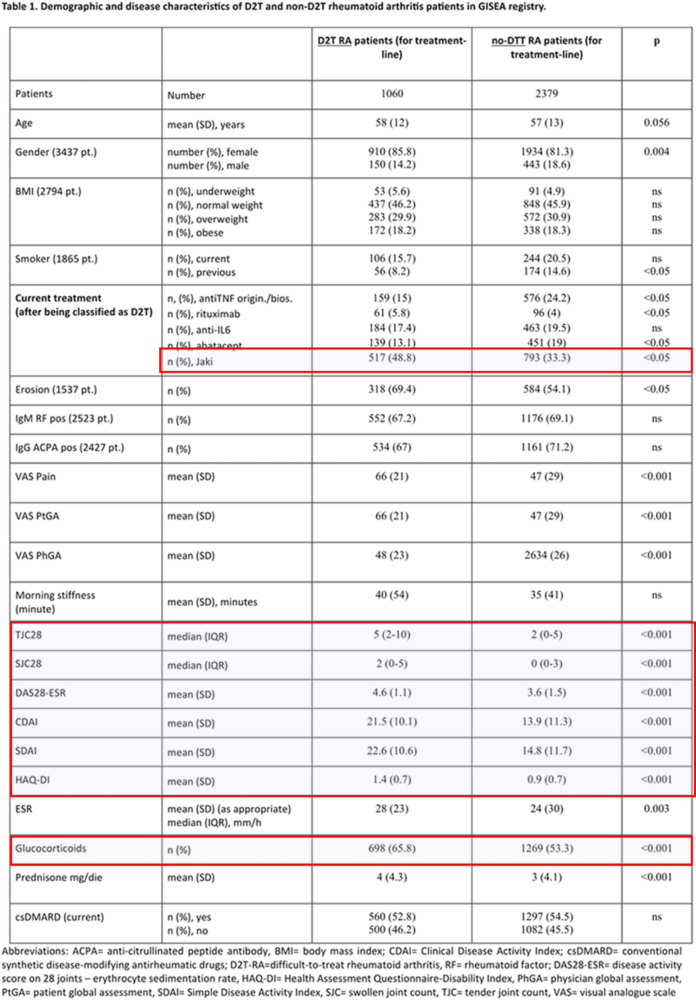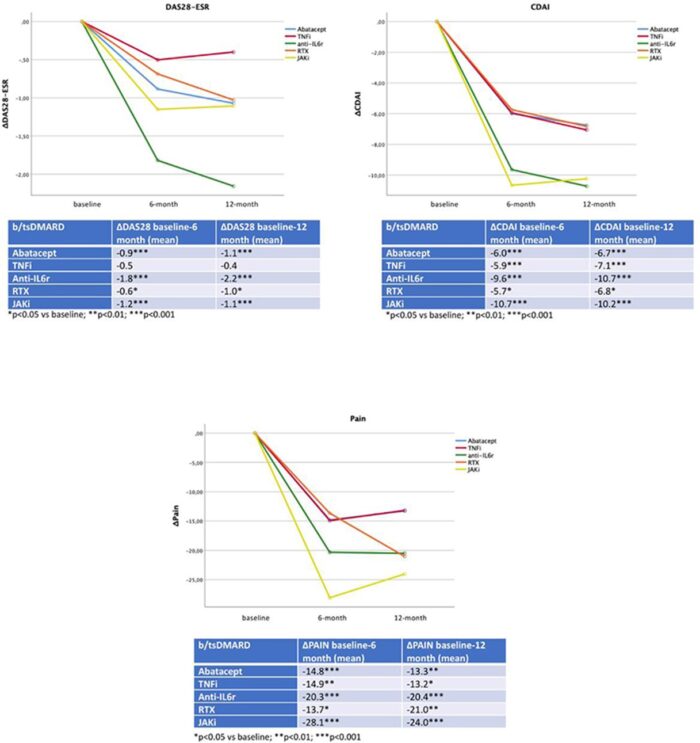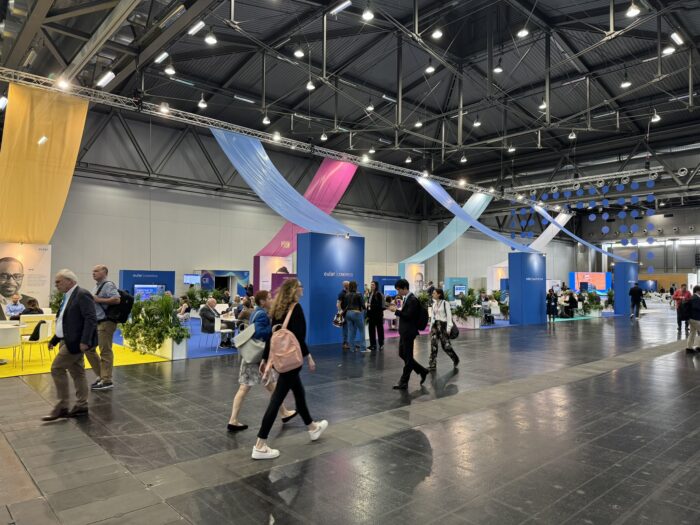EULAR2024 in VIENNAに参加しました(2)

みなさんこんにちは。
院長の伊達亮です。
先日開催された2024年6月12日(水)~2024年6月15日(土)にオーストリアのウィーンで開かれたヨーロッパのリウマチ学会(EULAR European League Against Rheumatism)に参加してきました。
この学会は、アメリカリウマチ学会(ACR)と並んでリウマチ学では世界中でも最も規模の大きい学会の一つです。
イタリアのM. Fornaro医師のポスター講演を拝見しました。
リウマチ治療において頭を悩ませることの一つに、治療を変えても症状が改善しない患者さんがいることです。2020年EULARが定義した「治療困難なRA」(D2T RA)という言葉があります。今回の学会では、特にD2Tに関するまとまった報告が多く特に力を入れて聞いてみました。
POS0671
PROFILE AND MANAGEMENT OF D2T-RA PATIENTS IN THE ITALIAN GISEA REGISTRY
M. Fornaro1
1Rheumatology Unit DiPReMeJ, University of Bari, Bari, Italy,
Background:
- Nowadays, numerous therapeutic options are available for patients with rheumatoid arthritis (RA), and the number of patients achieving remission has significantly increased.
- However, some patients have a disease defined by EULAR as “difficult-to-treat”(D2T), which today represents a new challenge for rheumatologists.
背景
- 今日、関節リウマチ(RA)患者には多くの治療選択肢があり、寛解を達成する患者数は著しく増加している。
- しかし、EULARが "難治性 "(D2T)と定義する患者もおり、リウマチ専門医にとって新たな課題となっている。
Objectives:
- The primary objective was to evaluate the characteristics of the D2T-RA population recorded in the Italian GISEA registry undergoing treatment with b/tsDMARDs.
- The secondary objective was to assess the effectiveness and changes at 6 and 12 months in disease outcomes, stratifying the analysis by different mechanisms of action.
対象
- 1番の目的はb/tsDMARDs で治療をうけたD2TRAの特徴をつかむこと
- 副次的な目的は、作用機序の違いによって層別化し、有効性と6ヵ月後および12ヵ月後の転帰の変化を評価すること
方法
- 2017年1月から2023年12月までにイタリアのGISEAレジストリに記録されb/tsDMARDsによる治療を受けたRA患者のデータを解析。
- 疾患活動性スコアなどをベースライン時および6ヵ月と12ヵ月のフォローアップ時に記録。
- D2T-RA患者は以下の3つの基準を満たすことにより定義
- 2種類以上のb/tsDMARDs(作用機序が異なる)が無効
- 活動性/進行性疾患を示唆する徴候(疾患活動性スコアによる少なくとも中等度の疾患活動性、および/またはグルココルチコイド治療≧7.5mg/日プレドニゾンまたは同等である
- 患者のVAS(Visual Analogue Scale)疼痛および/またはPtGA(Patient Global Assessment)および/またはPhGA(Physician Global Assessment)>20。
Results:
- The GISEA cohort included 5251 treatment lines with b/tsDMARDs.
- We were able to assess the D2T category for 3439 cases at the start of a new treatment.
- Overall, 1060 (30.8%) patients met all three criteria for D2T-RA
- While 2379 (69.2%) patients were not categorized as D2T.
- Table 1 reports patients with D2T-RA showed higher disease activity and PRO scores at baseline.
- Notably, JAK inhibitors (JAKis) were used more frequently in D2T-RA patients (48.8%) compared to non-D2T-RA patients (33.3%, p<0.05).
結果
- b/tsDMARDsによる5251例の治療成績を解析した。うち、 3439例を新規治療開始時にD2Tカテゴリーを登録できた。
- 1060例(30.8%)がD2T-RAの3つの基準をすべて満たした
- 2379例(69.2%)はD2Tに分類されなかった。
- 表1:D2T-RA患者はベースライン時の疾患活動性が高かった。
- JAK阻害薬(JAKis)がD2T-RA患者(48.8%)では非D2T-RA患者(33.3%、p<0.05)と比較して使用頻度が高かったことである。

結果続き
- The Globally, the 5-year survival rate was significantly lower for D2T-RA patients compared to those with non-D2T-RA (47.5% vs 62.5%, p<0.001).
- No significant differences in persistence were observed among the classes of b/tsDMARDs used in D2T-RA (log-rank test: 6.76, p=0.15), with a 5-year survivarate of 38.7% for abatacept, 41.2% for TNFi, 48.1% for IL6r inhibitors, 62.3% for anti-CD20, and 49.6% for JAK inhibitors.
- D2T-RA患者における薬剤の5年継続率は、非D2T-RA患者と比較して低かった(47.5% vs 62.5%)。 5年継続率はアバタセプト38.7%、TNFi41.2%、IL6r阻害薬48.1%、抗CD20薬62.3%、JAK阻害薬49.6%であった。

- Conclusion
- All currently used b/tsDMARDs appear to be effective in this patient cohort.
- The higher efficacy of JAK inhibitors, particularly in managing pain symptoms in these patients, warrants further investigation.
結論
- 現在、使用できるb/tsDMARDsは効果を発揮できている
- JAK阻害薬はD2T患者に対して特に高い有効率を示している。
D2T治療において、JAK阻害薬・リツキシマブの効果は高いとのことでした。1剤目のbDMARD治療が奏功しない場合のセカンドラインとして、候補の上位に上がる可能性が高いとおもいます。


学会場の風景です。
持ち物検査などがあり、国内学会とは警備体制が少し違う印象でした。
会場はとても広かったですが、導線がとてもスムーズでした。
文責 下関市 だて整形外科リハビリテーションクリニック 日本リウマチ学会 専門医 伊達亮
